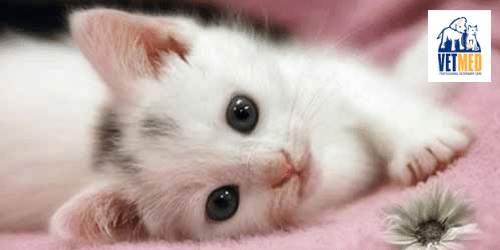Speying a female cat is an excellent step to help your young lady grow into a loving, well adapted household citizen. However at Vetmed we understand that making the decision to desex or spey your female kitten can be a scary one so we have put together some information to help you gain some understanding into both the procedure and the benefits for desexing your young lady.
Why do vets recommend desexing?
This is an easy one to answer – basically because there are so many health and behavior benefits for your little kitten. These include
- No heat behavior. During the heat cycle there are numerous behavior problems that may develop. Females will actively search out male cats, putting them in the danger of traffic and fights with other animals. In addition, unspayed females may spray urine when they are heat.
- Decreased risk of cancers. Mammary cancer is the third most common cancer in cats. Cats who have been spayed have a 40-60% lower risk of developing mammary cancer. Tumors also occur in the uterus and ovaries which are eliminated in speyed cats.
- Decreased risks of infections. Unspayed cats may develop a severe uterine disease called pyometra. With this disorder, bacteria enter the uterus and it becomes filled with pus. Undetected, this condition is almost always fatal.
- Population control. Many cats are euthanized because they are unwanted. Preventing unwanted litters of kittens is part of responsible pet ownership.
When is the best time to spey my kitten?
The best time to spey your kitten is around six months of age. This is because the kitten is old enough for the body to have matured enough to make the anesthetic low risk but young enough so she hasn’t reached sexual maturity yet.
What does speying a kitten involve?
In a feline spey, both ovaries and the uterus are removed through small incisions made through the skin of the abdomen just below the belly button while the kitten is under a general anaesthetic. There are sutures but these are hidden under the skin with only a small knot visible above the skin. This is generally a very quick and very painless procedure which only requires your kitten to be in hospital for the day.
What do I do before the procedure?
At Vetmed, kitten speys are performed Monday to Friday at all three of our vet hospitals by appointment only. When you ring to book in your young lady for desexing, our lovely reception staff will answer any questions you may have and reinforce any important details you need to know. It is very important that you kitten has nothing to eat from approximately 8pm the night prior to the surgery to ensure that there is nothing in her stomach which could lead to vomiting during the anaesthetic. It is also vital that your little one is brought into the veterinary hospital between the hours of 7:30 and 9:00 am as this allows our dedicated vets and vet nurses to preform their pre anesthetic health checks and procedures which ensure a painless, stress free procedure and to ensure that the risks involved are mitigated as much as possible.
What does the day of the procedure involve?
After you have dropped off your young lady with the vet nurses and you have signed the consent form giving permission for the procedure to take place, there are several procedures which take place prior to the induction of the general anaesthetic:
- Pre anaesthetic examination: It is important that your kitten is check over by a veterinarian prior to any sedation or pain relief to ensure that she is healthy and to ensure that there are no physical signs of illness.
- Pre anaesthetic blood tests: included in all of our anaesthetics, pre anaesthetic blood tests are preformed in-house and provide the veterinarian with vital information about the internal health of your young lady prior to any anaesthetic.
- Pre medication with sedation and painrelief: once the veterinarian has establised that your kitten in health using the physical exam and the blood tests, a sedation and painrelief is given via injection and your young lady is moved into a special area within the hospital especially designed for awaiting and recovering from anaesthetics.
- Induction of anaesthetic: once your kitten is sedated and she has plenty of painrelief provided, a catheter is inserted into her vein and the anaesthetic is inducted using a fast acting anaesthetic agent such as alfaxan. A tube is then placed into their throat to ensure that their airway is protected. She is then place on a mixture of oxygen and an inhalation anaesthetic to maintain her anaesthetic whilst and the procedure is completed
- Recovery: Once the deexing is finished, she will then be slowly woken up. This takes place in a special area of the hospital where specially designed cages provide plenty of warmth. Further painrelief is then provided to ensure that your young lady is relaxed and painfree as she slowly recovers. We allow at least 2 hours from the time she is awake till the time she is allowed to go home to eliminate any complications which can occur during this period
What about after the procedure? What should I expect at home?
The veterinarian or vet nurse will contact you as soon as your little one is in recovery but you must allow at least 2 hours after this call before you will be able to pick your young kitten up from the hospital. Your young lady will go home with medication such as painrelief, and you will be provided with a discharge statement which states how to use the medication, what to feed your little one and other important information. A vet nurse or veterinarian will go through this statement and how to give the medication.
Expect your little kitten to be a bit quiet on the night of the procedure but she should return to her normal self by the next morning. She will have sutures that will need to be checked in 7 days after the procedure. It is recommended that you do keep your little lady inside for those 7 days to give her time to heal. If you have any further questions we are always here to help. Please contact us at one of our three locations and one of our team members will be able to answer any questions.

